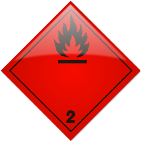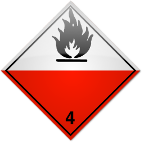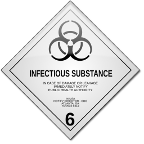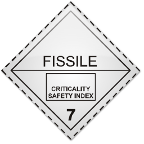



ADR Dangerous Goods
Dangerous goods are classified into 9 different classes, based on the dangerous properies of the goods or substance. If the goods have multiple dangerous propreties, the most dominant one determines the class to which it shall belong.
The classes are part of the United Nations-based system of identifying dangerous goods, and are used within many different subsystems such as the ADR, RID, IMDG and DGR for classifying dangerous goods and hazardous materials.
Class 1 contains substances and articles which pose a hazard due to explosion. Items in Class 1 are further divided into divisions 1.1 - 1.6 depending on the nature of the explosion hazard and the sensitivity of the item. A compatibility group, consisting of a single letter, is also assigned to each item. The compatibility group letter indicates which items can be transported together.

Class 2 contains potentially dangerous gases.
Gases in class 2 are assigned one or more groups, representing their dangerous properties.
| Group | Property |
|---|---|
| A | Asphyxiant |
| O | Oxidizing |
| F | Flammable |
| T | Toxic |
| TF | Toxic, Flammable |
| TC | Toxic, Corrosive |
| TO | Toxic, Oxidizing |
| TFC | Toxic, Flammable, Corrosive |
| TOC | Toxic, Oxidizing, Corrosize |
In some regulations, gases in class 2 are divided into divisions 2.1 - 2.3 depending on their primary hazard.
| Division | Primary hazard | Label |
|---|---|---|
| 2.1 | Flammable gases |  |
| 2.2 | Non-flammable, non toxic gases |  |
| 2.3 | Toxic gases |  |



Class 3 covers flammable liquids, which includes some molten solid substances and liquid desensitized explosives. Substances are divided into different packing groups according to the degree of danger they present to transportation.
| Packing group | Flash point | Initial boiling point |
|---|---|---|
| I | - | ≤ 35°C |
| II | < 23°C | > 35°C |
| III | ≥ 23°C ≤ 60°C | > 35°C |

Class 4, like class 5 and 6, is actually an umbrella term, where all substances belong to one of the subclasses.
| Class | Primary hazard | Label |
|---|---|---|
| 4.1 | Flammable solids, self-reactive substances, polymerizing substances and solid desensitized explosives |  |
| 4.2 | Substances liable to spontaneous combustion |  |
| 4.3 | Substances which, in contact with water, emit flammable gases |  |
They all have in common that they are flammable under certain conditions. For instance, strike-anywhere-matches (UN 1331) would be classified as a Class 4.1 substance.



| Class | Primary hazard | Label |
|---|---|---|
| 5.1 | Oxidizing substances |  |
| 5.2 | Organic peroxides |  |
Class 5.1, oxidizing substances, are substances that may decompose quickly, releasing oxygen or other oxidizing substances. This can cause a fire to accelerate quickly, or to start due to the heat given off in the oxidation process.
Class 5.2, organic peroxides, may also decompose at a high rate and give off oxygen or flammable gases, as well as heat. They can be very unstable and extremely flammable under certain circumstances such as heat, friction, mechanical shock, or when they come into contact with other substances.


| Class | Primary hazard | Label |
|---|---|---|
| 6.1 | Toxic substances |  |
| 6.2 | Infectious substances |  |
Class 6.1, toxic substances, is used to classify substances that - in relatively small amounts and in a short duration - can cause serious injury or death to humans if swallowed, inhaled or with by absorption through skin contact.
Class 6.2, infectious substances, covers substances which are known or are reasonably expected to contain pathogens, i.e. microorganisms (including bacteria, viruses, parasites and fungi) and other agents which can cause disease in humans or animals.


Class 7 contains substances and articles that are radioactive, meaning that they contain radionuclides where both the activity concentration and the total activity exceed certain threshold values defined in the regulations.
For some (Type A) materials and packages, a transport index is calculated on the basis of the maximum dose rate on the external surface of the packaging, and different labels and regulations apply depening on this index.
| Maximum dose rate on external surface | Transport index | Label |
|---|---|---|
| 0 |  | |
| >0.005 | 0-1 |  |
| >0.5 | 1-10 |  |
Other regulations and labels apply to radioactive waste and materials exceeding the limits for Type A packages.





Class 8 covers substances that can cause a chemical reaction that can potentially destroy living tissue or other goods. This includes substances which only form a corrosive substance in the presence of water, or produce corrosive vapour in the presence of moisture in the air.
| Category | Properties |
|---|---|
| C1-C4 | Acid substances |
| C5-C8 | Basic substances |
| C9-C10 | Other corrosive substances |
| C11 | Corrosive articles |
| CF | Corrosive substances, flammable |
| CS | Corrosive substances, self-heating |
| CW | Corrosive substances which, in contact with water, emit flammable gases |
| CO | Corrosive substances, oxidizing |
| CT | Corrosive substances, toxic and articles containing such substances |
| CFT | Corrosive substances, flammable, liquid, toxic |
| COT | Corrosive substances, oxidizing, toxic |

Substances and articles which, during carraige, present a danger not covered by any of the other classes fall under class 9.
| Category | Properties |
|---|---|
| M1 | Substances which, on inhalation as fine dust, may endanger health |
| M2 | Substances and articles which, in the event of fire, may form dioxins |
| M3 | Substances evolving flammable vapour |
| M4 | Lithium batteries |
| M5 | Life-saving appliances |
| M6 - M8 | Environmentally hazardous substances: M6: Pollutant to the aquatic environment, liquid M7: Pollutant to the aquatic environment, solid M8: Genetically modified microorganisms and organisms |
| M9 - M10 | Elevated temperature substances: M9: Liquid M10: Solid |
| M11 | Other substances and articles presenting a danger during carriage, but not meeting the definitions of another class. |